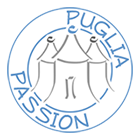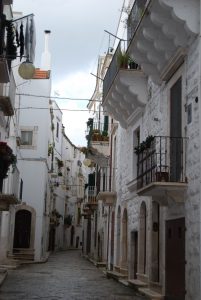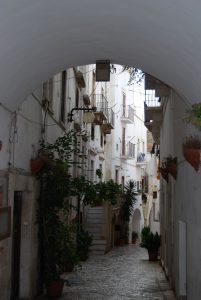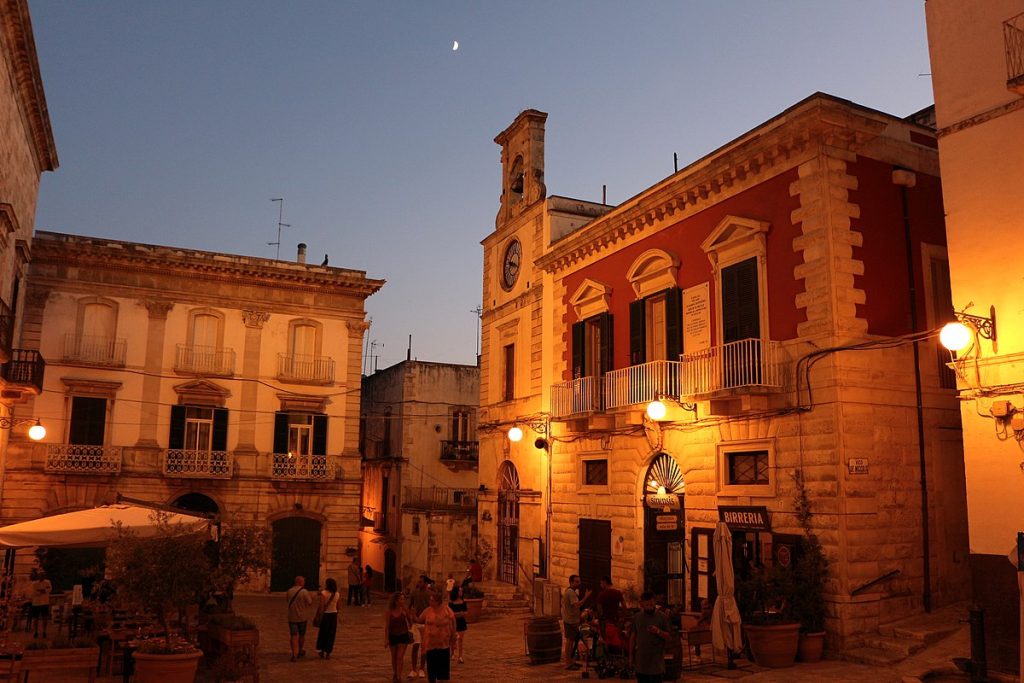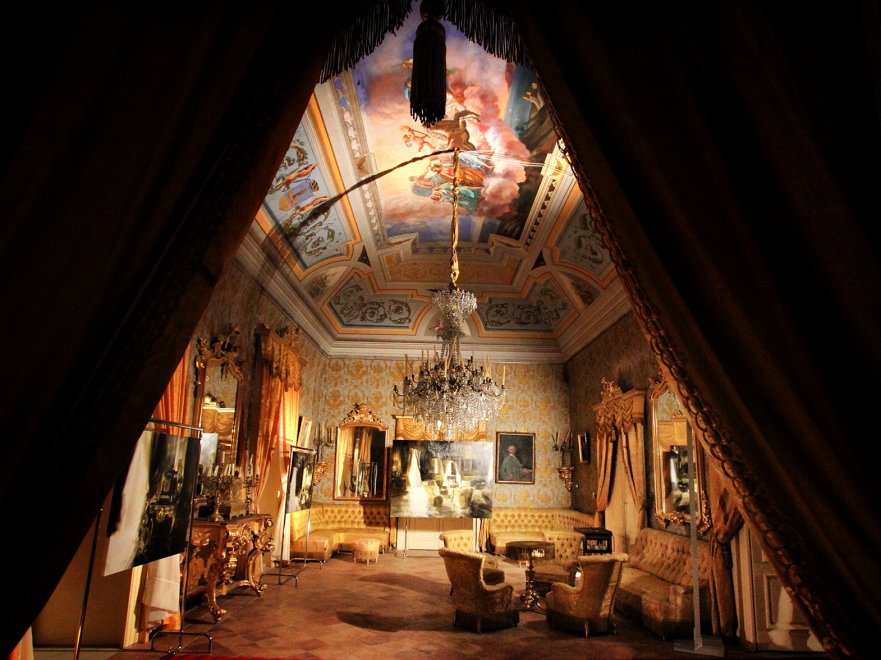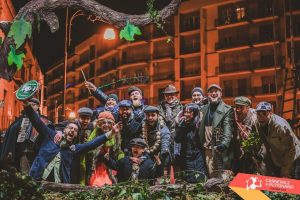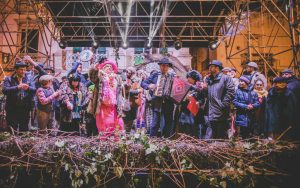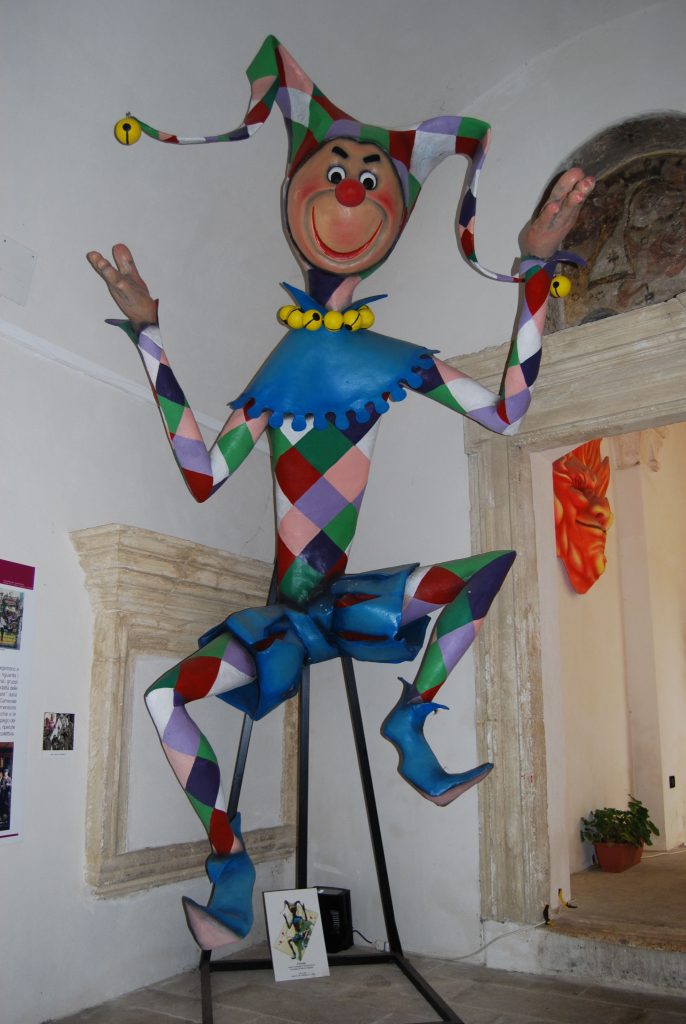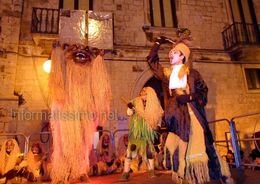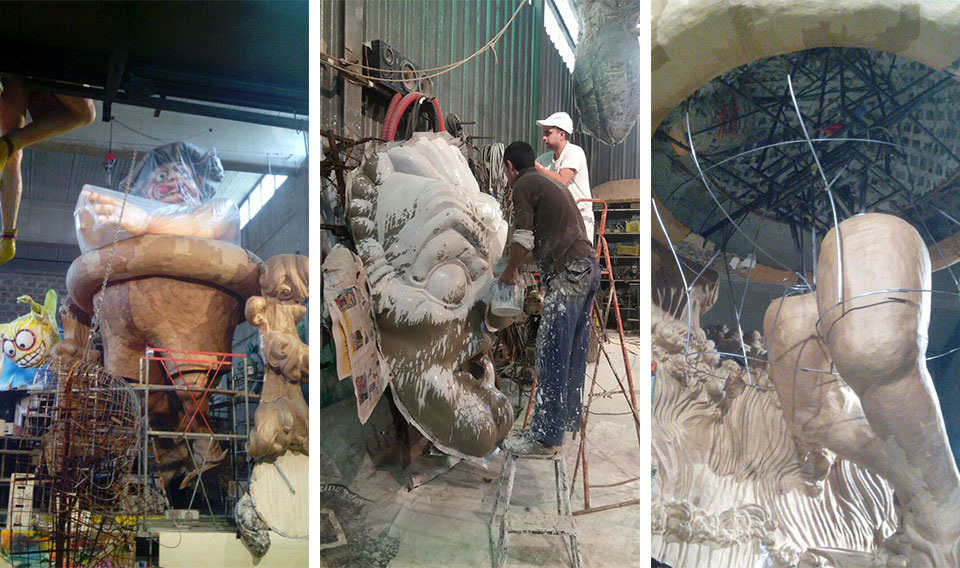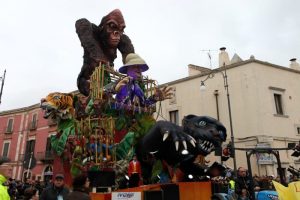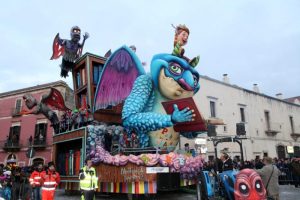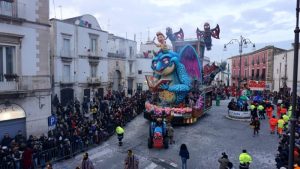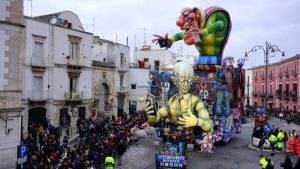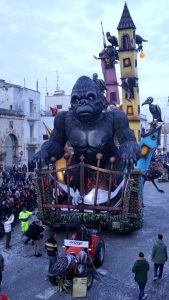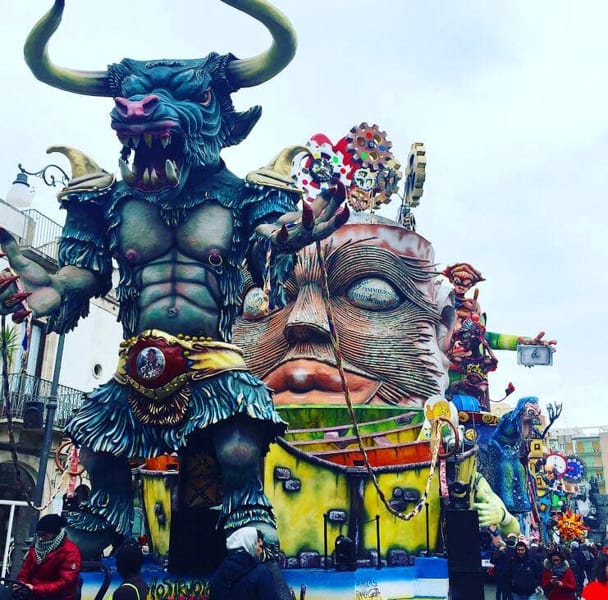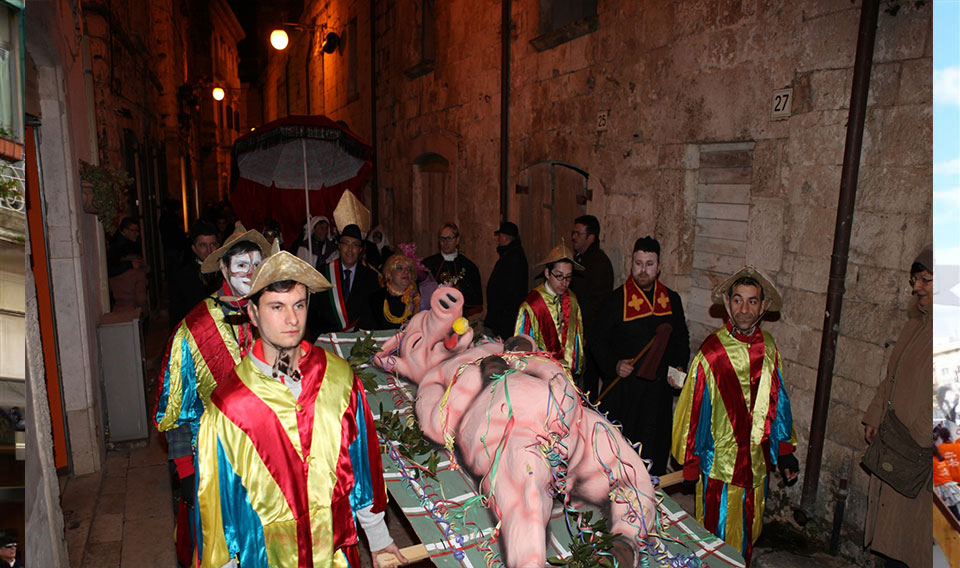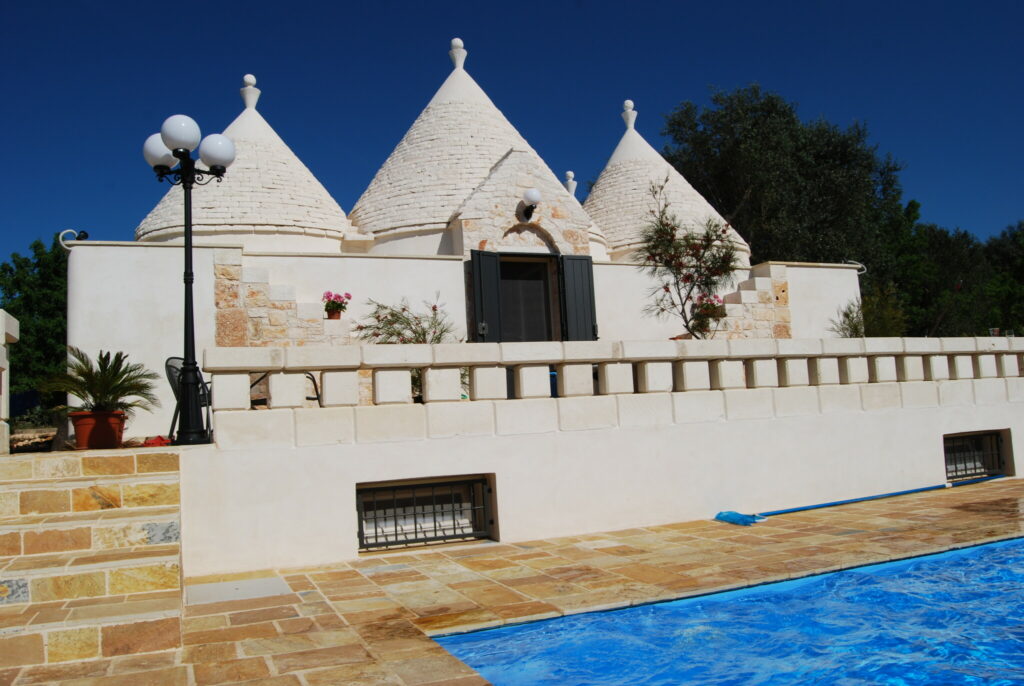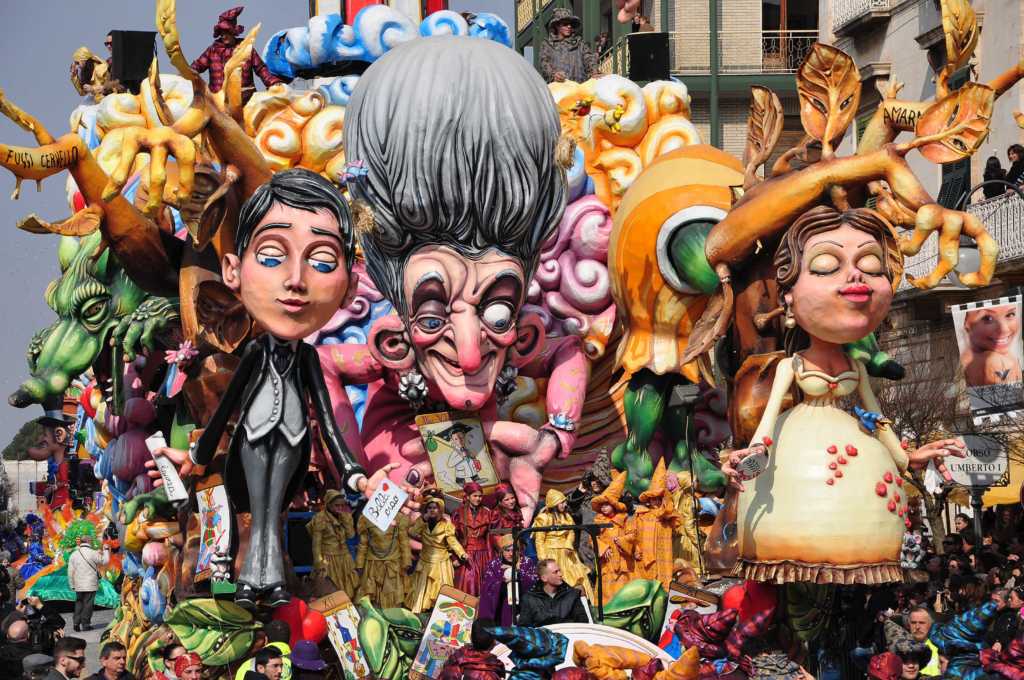
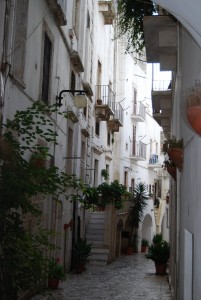
Situated inland south of Bari and north of Alberobello is the town of Putignano. It has a population of about 27,000, but its bustling central area gives it a feel of a bigger town. It is about an hour's drive from Ostuni via the Val d'Itria, and easily reached from Bari by road, bus and rail (on the local Ferrovaria Sud Est).
Putignano is not on the "tourist trail" but with one major exception - it is the home of possibly the oldest and certainly the longest celebration of Carnevale in Italy. Between Christmas and the start of Lent (usually in February but sometimes well into March) it is the scene of a huge programme of activities, displays and large scale street processions - see details below.
If you are interested in getting lost in winding narrow streets, then Putignano is for you - it is the only centro storico in Puglia where we have got genuinely disoriented. The centro storico is ringed by the main street of the modern town, and consists entirely of narrow streets with a few tiny squares - even the main piazza (Plebiscito) is tiny. This lack of a focal point is really confusing to the visitor, not helped by an absence of any signs and street plans! You find yourself coming out onto the modern perimeter in unexpected places.
Outside the Carnevale season, the centro storico is pretty quiet. It is well populated, but there are hardly any shops, bars or restaurants there.
In the Piazza Plebiscito is the Chiesa Madre di Sant Pietro Apostolo, a romanesque church, and also the Palazzo del Bali, which was once the home of the Knights of Malta and is now a part time civic museum and art gallery. This is worth visiting if you get the opportunity - try clicking here for opening hours. Admission costs 6 euros with concessions for children etc.
The Palazzo dates from the fourteenth century, founded by the Knights of Malta. It became the residence of the Bali family until the early 1800s, then it passed to Romanazzi-Carducci family, which used it as a palatial residence. It is richly decorated and contains valuable furniture, paintings, books, tapestries, porcelain, silverware and crystal; an important collection of weapons; and a display of aristocratic shoes! A highlight is the "Yellow Room", used for social gatherings and musical evenings.
However, Putignano is principally famous for its Carnevale celebrations, which are officially recognised and promoted among the nationally recognised Carnevale of Italy (so it ranks alongside Venice, Viareggio in this respect).
Carnevale is a pagan tradition adopted by Catholic Italy and many parts of the world, a period of partying and high spirits preceding the six weeks pre-Easter privations of Lent. The culmination of Carnevale is Martedi Grasso (Fat Tuesday, Mardi Gras, Shrove Tuesday), the day before Lent commences; but in many places the Carnevale season extends before this date and occasionally just beyond it.
Putignano Carnevale claims to be the oldest in Europe, dating back to 1394. It is certainly the longest Carnevale period in Italy, lasting from the 26th December (St Stephen's Day) until Martedi Grasso; when Easter is late, which pushes this into March, it really is a long period. There are all sorts of events and activities throughout, including some large scale spectacles which are well worth seeing if you get the opportunity. (NB Recently as a special tourist attraction there has been a special re-run of the main processions on the last weekend of July).
The Carnevale origins track back to 1394 when the relics of Saint Stephen were transferred to Putignano from Monopoli, where they had become vulnerable to Saracen coastal raids. The town's inhabitants marked the occasion with a celebration which has lasted ever since. Today, the Carnevale events feature parades of huge grotesque models and masks, music, dancing, theatrical performances etc. Local people dress up in costumes and masks, houses and shops are decorated, and generally revelry is encouraged. Although its origins are religious, Carnevale here is very distinctly irreverent and anti-establishment. All events involve music, dancing, food and drink of course - Carnevale is essentially a big party to precede the sobriety and restrictions of Lent.
The season kicks off on 26 December with a ceremonial lighting of candles to obtain advance forgiveness for sins committed during Carnevale (a nice touch we think!). This is then followed in the evening by a traditional competition called Le Propaggini. These are seven outdoor presentations, 20 minutes or so long, by groups in costumes of workers and peasants. Presentations are of specifically composed satirical poetry based on local history, traditions and personalities, generally mocking politicians, institutions and even the Church - but all sung in the local Putignanese dialect. The competition is hotly contested.
On 17 January, the feast of San Antonio Abate (the patron saint of livestock and livestock breeders) is celebrated by a blessing of animals followed by a blessing of mozzarella cheese - essentially a festival of food and drink. This is also the day when Carnevale masks and models first appear. The signature mask in Putignano is called Farinella - named after a flour mixture of chickpeas and toasted barley which is associated with Putignano. Currently this model is based on the Joker in a pack of cards, with a multi coloured costume and a two headed hat with rattles on. This mask/model features throughout the Carnevale.
Throughout Carnevale, there is a special satirical street party every Thursday, with themes and traditions in a strict traditional sequence, each featuring a particular group of people - priests, nuns, widows, unmarried youth, married women and married men. The last of these is especially elaborate.
On 2 February, known as Candlemas, there is a religious celebration involving blessing of candles, followed by the Festival of the Bear, when a street theatrical production is mounted involving a man dressed as a bear announcing the end of winter if the weather is poor, or that spring is still a long way off if the weather is sunny and mild. This tradition is said to be a pre-Christian concern with the new season's prosperity. The Bear is hunted through the streets by people in costume. In the spirit of Carnevale, there is always allegory - in 2018 the Bear represented the President of Puglia, Michele Emiliano, who was hunted through the streets and put on trial for his role in closing a local hospital!
However, the main events of Putignano carnevale come towards the end, and involve especially four processions of seven carriages bearing enormous papier-mache models and displays, surrounded by singers, dancers, acrobats, musicians etc. These take place on the evening of Martedi Grasso itself, and the afternoons of the three preceding Sundays. These are truly large scale occasions, and you have to pay to get admission to the streets to watch the spectacle (roughly 10 euros per head, with various concessions).
The displays are based on a theme - the 2019 theme is "Satire and Freedom". In recent years the themes have been Fellini's films (2013), Verdi's music (2014), Seven Deadly Sins (2015), Diversity (2016), Monsters (2017), Heroes (2018). Various associations compete for the seven slots, submitting sketches and ideas to a panel about six months in advance. There is tough competition to be selected and to be judged the best display; the prize money (from sponsorship and income) is significant.
The skills and techniques of cartapesta (papier mache) sculpture are carefully nurtured in Putignano, and the specialist artists and technical teams involved in the "associations" are highly regarded. During the months leading up to their launch, the enormous displays are assembled in carefully guarded lofty workshops. It involves producing moulds in clay and gypsum, making wire frames, constructing the models in old newspaper soaked in a special glue, finally intricate painting and refinement.
Here are a couple of Youtube videos which give an idea of the atmosphere of the processions of grotesque models
This one is from 2017 when the theme was "Monsters"
This one is from 2015 when the theme was "Seven Deadly Sins"
Whatever the theme, it is usual to see grotesque caricatures of public figures - you may well recognise Silvio Berslusconi, Angela Merkel, Donald Trump, Matteo Renzi.
The conclusion of Carnevale is a huge procession on the evening of Martedi Grosso. It finishes with a funeral of the Carnevale, represented by a papier mache pig, which is ceremoniously burned after being carried through the streets. And just before midnight 365 recorded church bell chimes, next to a huge papier mache bell, signal the end of Canevale and the start of Lent - although eating, drinking and general merrymaking do continue into the early hours.
Have a look at this link for up to date details of Putignano carnevale, including how to obtain on line tickets for the four big days.
http://www.carnevalediputignano.it/programma
In recent years the city has also staged a summer festival featuring the cartapesta models in addition to the traditional early year celebrations; this is in the evenings of the last weekend in July.
